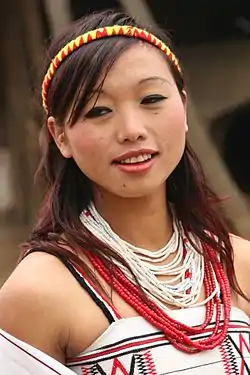Naga people
Nagas[4] are various ethnic groups native to the northeastern India and northwestern Myanmar. The groups have similar cultures and traditions, and form the majority of population in the Indian state of Nagaland and Naga Self-Administered Zone of Myanmar; with significant populations in Manipur, Arunachal Pradesh and Assam in India; Sagaing Division and Kachin State in Myanmar.
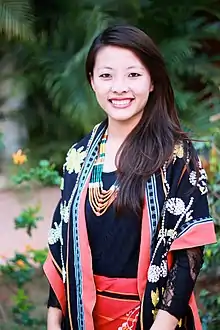 A Tangkhul Naga woman in her traditional outfit | |
| Total population | |
|---|---|
| 2.8 millions+(approx) | |
| Regions with significant populations | |
| India | 2.7 millions+[1] |
| Nagaland | 1,700,000 |
| Manipur | 700,000 |
| Arunachal Pradesh | 200,000 |
| Assam | 40,000 - 80,000 |
| Meghalaya | 3,000 |
| Mizoram | 1,000 |
| Myanmar | 300,000[2] |
| Naga SAZ | 120,000+[3] |
| Sagaing Division | NA |
| Kachin State | NA |
| Languages | |
| Naga languages, Northern Naga languages, Nagamese Creole, English | |
| Religion | |
| Christianity (majority); Theravada Buddhism; Animism; Heraka | |
| Related ethnic groups | |
| Meiteis, East Asians, Singphos, Tamans†, etc | |
The Nagas are divided into various Naga ethnic groups whose numbers and population are unclear. They each speak distinct Naga languages often unintelligible to the others.
Etymology
The present day Naga people have been called by many names, like 'Noga' by Assamese[5] 'Hao' by Manipuri[6] and 'Chin' by Burmese.[7] However, over time 'Naga' became the commonly accepted nomenclature. According to the Burma Gazetteer, the term 'Naga' is of doubtful origin and is used to describe hill tribes that occupy the country between the Chin in the south and Kachin (Singpho) in the Northeast.[8]
Languages
The Naga languages are either classified under the Kuki-Chin-Naga languages or the Sal languages.
Nagas have more language diversity than any other ethnic group or states in India. Naga people speak over 89 different languages and dialects, mostly unintelligible with each other. However, there are many similarities in between different languages spoken by them. The diversity of languages and traditions of the Nagas results most likely from the multiple cultural absorptions that occurred during their successive migrations. According to legend, before settling in the region, these groups moved over vast zones, and in the process, some clans were absorbed into one or more other groups. Therefore, until recent times, absorptions were a source of many interclan conflicts.[9]
In 1967, the Nagaland Assembly proclaimed English as the official language of Nagaland and it is the medium for education in Nagaland. Other than English, Nagamese, a creole language form of the Assamese language, is a widely spoken language. Every community has its own mother tongue but communicates with other communities in either Nagamese or English. However, English is the predominant spoken and written language in Nagaland.
Culture
Art
The Naga people love colour as is evident in the shawls designed and woven by women, and in the headgear that both sexes design. Clothing patterns are traditional to each group, and the cloths are woven by the women. They use beads in variety, profusion and complexity in their jewelry, along with a wide range of materials including glass, shell, stone, teeth or tusk, claws, horns, metal, bone, wood, seeds, hair, and fibre.[10]
According to Dr. Verrier Elwin, these groups made all the goods they used, as was once common in many traditional societies: "they have made their own cloth, their own hats and rain-coats; they have prepared their own medicines, their own cooking-vessels, their own substitutes for crockery.".[11] Craftwork includes the making of baskets, weaving of cloth, wood carving, pottery, metalwork, jewellery-making and bead-work.
Weaving of colorful woolen and cotton shawls is a central activity for women of all Nagas. One of the common features of Naga shawls is that three pieces are woven separately and stitched together. Weaving is an intricate and time consuming work and each shawl takes at least a few days to complete. Designs for shawls and wraparound garments (commonly called mekhala) are different for men and women.
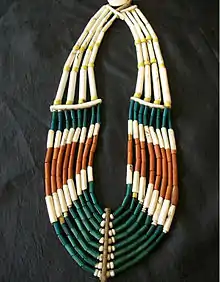
Among many groups the design of the shawl denotes the social status of the wearer. Some of the more known shawls include Tsungkotepsu and Rongsu of the Aos; Sutam, Ethasu, Longpensu of the Lothas; Supong of the Sangtams, Rongkhim and Tsungrem Khim of the Yimchungers; and the Angami Lohe shawls with thick embroidered animal motifs.
Naga jewelry is an equally important part of identity, with the entire tribe wearing similar bead jewelry.
The Indian Chamber of Commerce has filed an application seeking registration of traditional Naga shawls made in Nagaland with the Geographical Registry of India for Geographical Indication.[12]
Cuisine
.jpg.webp)
Naga cuisine is characterized by smoked and fermented foods.
Folk song and dances
Folk songs and dances are essential ingredients of the traditional Naga culture. The oral tradition is kept alive through the media of folk tales and songs. Naga folk songs are both romantic and historical, with songs narrating entire stories of famous ancestors and incidents. Seasonal songs describe activities done in a particular agricultural cycle. The early Western missionaries opposed the use of folk songs by Naga Christians as they were perceived to be associated with spirit worship, war, and immorality. As a result, translated versions of Western hymns were introduced, leading to the slow disappearance of indigenous music from the Naga hills.[13]
Folk dances of the Nagas are mostly performed in groups in synchronized fashion, by both men and women, depending on the type of dance. Dances are usually performed at festivals and religious occasions. War dances are performed mostly by men and are athletic and martial in style. All dances are accompanied by songs and war cries by the dancers. Indigenous musical instruments made and used by the people are bamboo mouth organs, cup violins, bamboo flutes, trumpets, drums made of cattle skin, and log drums.[14]
Festivals
The various Naga groups have their own distinct festivals. To promote inter-group interaction, the Government of Nagaland has organized the annual Hornbill Festival since 2000. Another inter-tribe festival is Lui Ngai Ni. The group-specific festivals include:[15]
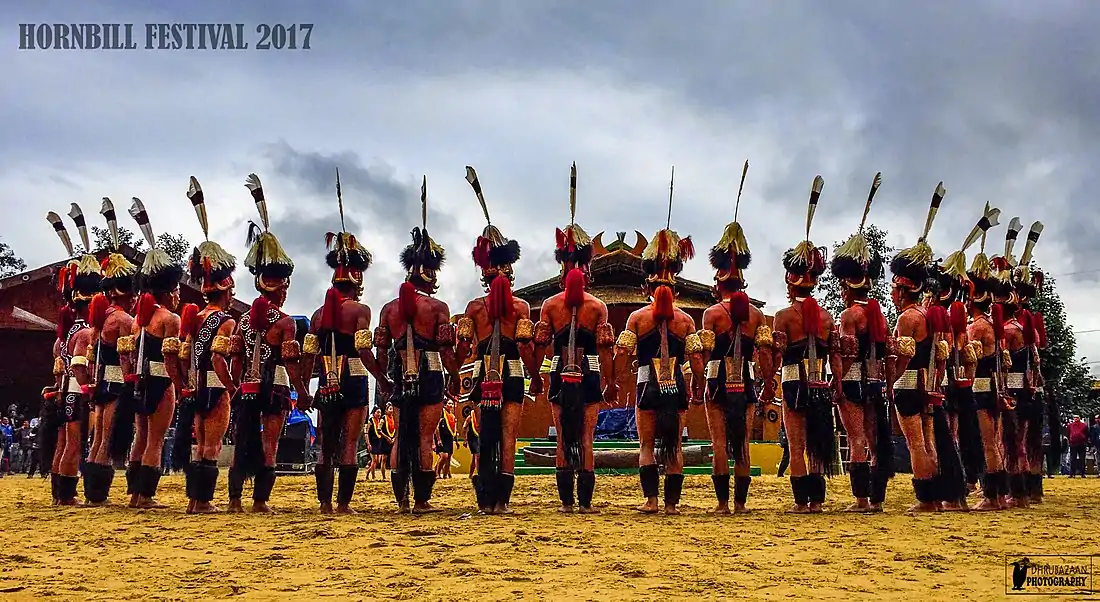
| Festival | Ethnic group | Time | Major center |
|---|---|---|---|
| Chiithuni festival | Mao | January (7) | Mao Gate |
| Sekrenyi | Angami | February | Kohima |
| Chavan kumhrin | Anal Naga | October (23) | Chandel |
| Ngada | Rengma | November (last week) | Kohima |
| Luira Phanit | Tangkhul Naga | February/March | Ukhrul |
| Chagaa, Gaan-Ngai, Hega n'gi, Mlei-Ngyi | Zeliangrong Communities - (Liangmei, Rongmei, and Zeme) | December (last week), 10 March for Melei-Ngyi | Tamenglong-Cachar, Jalukie |
| Sükhrünyie, Tsükhenyie | Chakhesang | January & March/April | Phek |
| Yemshi | Pochury | September/October | Phek |
| Moatsü | Ao | May (first week) | Mokokchung |
| Aoleang | Konyak | April (first week) | Mon |
| Monyu | Phom | April (first week) | Longleng |
| Miu | Khiamniungan | May (second week) | Tuensang |
| Naknyu Lem | Chang | July (second week) | Tuensang |
| Metemneo | Yimchunger | August (second week) | Tuensang |
| Amongmong | Sangtam | September (first week) | Tuensang |
| Tokhu Emong | Lotha | November (first week) | Wokha |
| Tuluni | Sumi | July | Zunheboto |
| Thounii Festival | Poumai Naga | January (18th to 22nd) | Senapati |
Naga identity
The word Naga originated as an exonym.[16] Today, it covers a number of ethnic groups that reside in Nagaland, Manipur, Assam and Arunachal Pradesh states of India, and also in Myanmar.
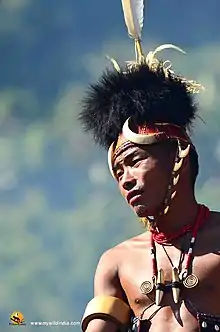
Before the arrival of the British, the term "Naga" was used in Assam to refer to certain isolated ethnic groups. The British adopted this term for a number of ethnic groups in the surrounding area, based on loose linguistic and cultural associations. The number of groups classified as "Naga" increased significantly in the 20th century: as of December 2015, 89 groups are classified as Naga by the various sources. This expansion in the "Naga" identity has been due to a number of factors including the quest for upward mobility in the society of Nagaland, and the desire to establish a common purpose of resistance against dominance by other groups. In this way, the "Naga" identity has not always been fixed.[17]
The Kuki people of Nagaland have been classified as "Naga" in the past, but today are generally considered a non-Naga. The Kuki have had good relations with the Naga in the past, but since the 1990s, conflicts have risen, especially in Manipur.
Nagas in India
Several Naga tribes are listed as scheduled tribes in 6 Indian States i.e. Arunachal Pradesh, Assam, Manipur, Meghalaya, Mizoram and Nagaland.[18]
Nagas in Myanmar
Nagas in Myanmar are mostly found in Sagaing Division and Kachin state. The Naga territory in Myanmar is marked by Kabaw valley in the south bordering to the Chin state, the Kachin on the north and the Burmese on the east.[19]
The Major Naga ethnic groups in Myanmar are:
Some other minor Naga groups are Anal, Lamkang, Moyon, Koka, Longphuri, Paung Nyuan, etc
The townships which are inhabited by the Nagas are:
- Homalin
- Lahe with Tanbakwe sub-township
- Layshi with Mowailut sub-township and Somra sub-township
- Hkamti
- Nanyun with Pangsau and Dunghi sub-township
- Tamu of Sagaing Division and
- Tanai of Kachin state
Anal and Moyon are mainly found in Tamu township on the south and a few Somra Nagas are also found in and around Tamu bordering to Layshi jurisdiction. Makury, Para and Somra tribes are mainly found in Layshi township. Makury Nagas and a few Somra Nagas are also found in Homalin township. Lahe is highly populated by Konyak, Nokko, Lainong and Makury tribes. Nanyun on the north is the home of Tangshang tribe which comprises more than 54 sub-dialect groups. Homlin township is highly populated by the considered lost tribes (Red Shans). But Kukis, Burmese, Chinese and Indians are also found there. Hkamti township is populated altogether by all the Naga tribes majority and with a number of Burmese, Shans, Chinese and Indians. Tanai in Kachin state of Myanmar is inhabited by the Tangshang Nagas among the Kachin people.
See also
- History of the Nagas
- List of Naga ethnic groups
- List of Naga languages
- List of Naga people
References
- "Census of India". Census India. MHA, Govt ofIndia.
- "Naga ethnic group Myanmar".
- "Nagas of Myanmar".
- "Nagas". Minority Rights Group. Retrieved 27 November 2020.
- Grierson. Linguistic Survey of India Vol iii part ii. p. 194.
- Hodson, TC (1911). The Naga tribes of Manipur. p. 9.
- Upper Chindwin District vol A. Burma Gazetteer. p. 22.
- Burma Gazetteer, Upper chindwin vol A. page 23. published 1913
- Drouyer, Azevedo, Isabel, Drouyer, René, THE NAGAS -MEMORIES OF HEADHUNTERS vol.1, White Lotus, 2016, p. 7
- Ao, Ayinla Shilu. Naga Tribal Adornment: Signatures of Status and Self (The Bead Society of Greater Washington. September 2003) ISBN 0-9725066-2-4
- "Arts and crafts of the Nagas" Archived 19 June 2009 at the Wayback Machine, Nagaland, Retrieved 23 June 2009
- "Naga shawls in for geographical registration", AndhraNews.net, 7 April 2008
- Shikhu, Inato Yekheto. A Re-discovery and Re-building of Naga Cultural Values: An Analytical Approach with Special Reference to Maori as a Colonized and Minority Group of People in New Zealand (Daya Books, 2007), p. 210
- Mongro, Kajen & Ao, A Lanunungsang. Naga Cultural Attires and Musical Instruments (Concept Publishing Company, 1999), ISBN 81-7022-793-3
- "Tourism: General Information". Government of Nagaland. Archived from the original on 30 October 2011. Retrieved 24 October 2011.
- Christopher Moseley (6 December 2012). Encyclopedia of the World's Endangered Languages. Routledge. pp. 572–. ISBN 978-1-135-79640-2. Retrieved 8 September 2013.
- Arkotong Longkumer (4 May 2010). Reform, Identity and Narratives of Belonging: The Heraka Movement in Northeast India. Continuum. pp. 6–7. ISBN 978-0-8264-3970-3. Retrieved 8 September 2013.
- https://tribal.nic.in/ST/LatestListofScheduledtribes.pdf
- http://morungexpress.com/nagas-myanmar-people-forgotten-land
Further reading
- Drouyer, A. Isabel, Drouyer René, " THE NAGAS: MEMORIES OF HEADHUNTERS- Indo-Burmese Borderlands vol.1"; White Lotus, 2016, ISBN 978-2-9545112-2-1.
- Wettstein, Marion. 2014. Naga Textiles: Design, Technique, Meaning and Effect of a Local Craft Tradition in Northeast India. Arnoldsche, Stuttgart 2014, ISBN 978-3-89790-419-4.
- von Stockhausen, Alban. 2014. Imag(in)ing the Nagas: The Pictorial Ethnography of Hans-Eberhard Kauffmann and Christoph von Fürer-Haimendorf. Arnoldsche, Stuttgart 2014, ISBN 978-3-89790-412-5.
- Shongzan, Mayaso, "A Portrait of the Tangkhul Nagas"; Exodus, 2013, ISBN 978-81-929139-0-2.
- Stirn, Aglaja & Peter van Ham. The Hidden world of the Naga: Living Traditions in Northeast India. London: Prestel.
- Oppitz, Michael, Thomas Kaiser, Alban von Stockhausen & Marion Wettstein. 2008. Naga Identities: Changing Local Cultures in the Northeast of India. Gent: Snoeck Publishers.
- Kunz, Richard & Vibha Joshi. 2008. Naga – A Forgotten Mountain Region Rediscovered. Basel: Merian.
- Singh, Waikhom Damodar (21 June 2002). "The Indo - Naga Ceasefire Agreement". Manipur Online (originally published in The Sangai Express). Archived from the original on 26 May 2005.
- Shimray, Atai, A.S. - "Let freedom ring?: Story of Naga nationalism".
Novels
- Ben Doherty, Nagaland, Wild Dingo Press, Melbourne, 2018, ISBN 978-0-6480-6637-8.
External links
| Wikimedia Commons has media related to Naga people. |
